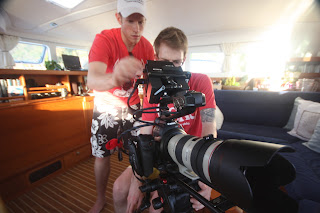Soterion: Your Adventure Awaits from James Knightly on Vimeo
Now this was a fun shoot. How could it not be?
My mission was to create a commercial for a 57-foot catamaran that does private week-long charters in the British Virgin Islands. Good start, right? Oh also, the owner graciously gave me almost unlimited creative freedom with it- there were no stipulations. The video would play on the boat's website and possibly other chartering companies' sites. He wanted a 2 +/- minute version and a 30 second version.
As I began thinking about how I would approach it, the two most important things to me were:
1) I didn't want the Islands to seem unreal, I wanted them to feel "attainable," almost "relatable." Growing up, whenever I saw pictures of the Caribbean, I always assumed the pictures where doctored- the green picturesque water, the palm trees, the hammocks on the beach. Nothing could really look like that. When I traveled there a year or so ago on a separate trip, I realized that the water was actually that color. However, the pictures I had seen were always overly saturated and contrasty.
I wanted to earn the viewer's trust from the very first shot by being honest about how things actually look. I shot Canon Log, so I had to add back in the contrast and saturation in color grading, but I was very careful about how much I dialed in. Accurate, not enhanced. I hope this comes through in the overall look.
2) I wanted this to feel like the boat was a character- the viewer's "noble steed" or tour guide. It enables you to take this journey. I was nervous about this approach because I purposefully did not shoot much of the boat's interior. On the last day, I shot one of the cabins but knew I'd never use the footage. It felt way too much like a real estate video with slow tilts and pans. "Here's the dining room, here's the spacious living room, etc." It had to be about where the boat could take you, what it enabled you to do. Time will tell if this approach drives business or if I should have made a cheesy sunset montage instead :)
Technical Info:
I shot with my Canon C100 and Nikkor primes- 20, 35, and 55 macro. I also had a 70-200 2.8 is. More than half the shots were recorded to a Pix 240. When I was concerned about weight or speed, I'd forego the Pix and just shoot internally. Most underwater shots were done by my great friend and collaborator, Kenny Abbott, with his GoPro Hero 3. I shot Canon Log, he shot in ProTune. The GoPro footage required a good deal of grading to match color, but the 2.7K was a joy to have.
As far as other gear, I brought a Cinevate Atlas 10 slider, a Manfrotto tripod, monopod, my 7D for time-lapse, and my MacBook Pro.
This was the first job I did with the C100 and I definitely put it through the ringer. The temperatures were high and the sun was blazing. At one point, we were shooting a beach for an hour in the sun and I was recording to the Pix 240 and internally to SD cards. When we watched dailies that night, some of the Pix footage had crazy digital artifacts (see picture below) because of the heat.
 |
| Digital Glitch in Pix 240 file |
The lowlight ability of today's cameras always amazes me. The dinner scene was lit with a small LED light I had, a flashlight and a fluorescent lamp we found on board. I think we shot at 3200 ISO.
 |
| Key: Flolight Microbeam 128. Kicker: Flashlight |
 |
| Yellowtail Snapper |
 |
| Planning the route |
 |
| Setting up the Pix with Kenny |
 |
| Geronimo! |
 |
| Scared of heights? |
 |
| The human head: best slider support |
 |
| Dailies |
 |
| Sasha gave me the hat |
Thanks for reading!
Questions? Ask away.
- James



















